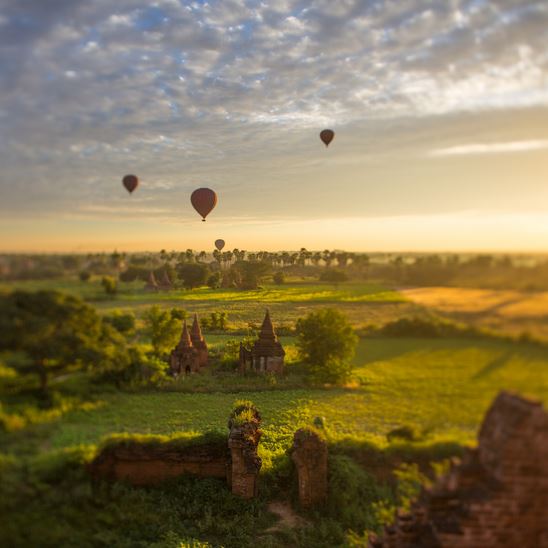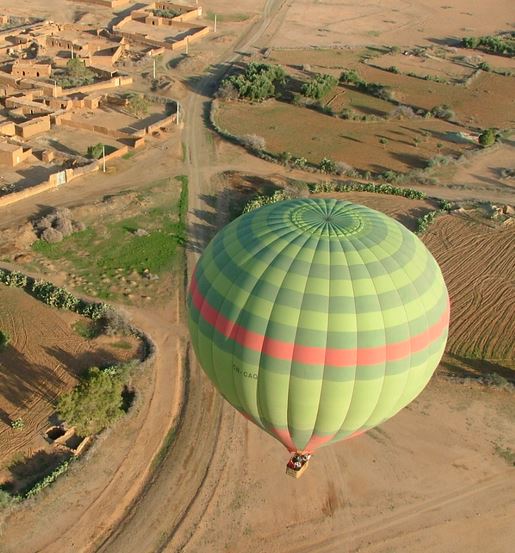This is the time of year when we reach out to you, our families, friends, colleagues and guests, to tell you how grateful we are to each of you, and to say thank you. We wish you many blessings & a happy, safe holiday. The U.S. office will be closed this Thursday and Friday to spend time with our families.
Come Monday, consider wrapping up a great getaway with Big Five’s #CyberMonday offers, which are valid for bookings that originate on Cyber Monday, with booking completed by December 31, 2014. Travel is valid to Dec. 31, 2015.
Book our new 11-day Chile & the Culture of the Mapuche journey on Cyber Monday and receive a complimentary 3-night excursion to Iquique. Explore Santiago, Pucon, Huil Huilo and Atacama.
The first manned hot air balloon happened on November 21, 1783! Two French brothers, Joseph and Etienne Montgolfier, launched their balloon from the center of Paris and it flew for 20 minutes. On January 7, 1793, George Washington was on hand to witness the first launch of a hot air balloon in North America. Today, hot air ballooning has become a popular activity with balloon festivals the world over. You can even visit the National Balloon Museum & U. S. Ballooning Hall of Fame in Indianola, Iowa.
Hot air ballooning offers perspectives you would not otherwise enjoy. Indeed, many of us have that special balloon ride on our bucket lists. We selected five really spectacular balloon opportunities.
Bagan, Myanmar: Imagine an early morning flight over the magnificent temples of Bagan, drifting over the temples of this ancient city giving you views that no ancient king or mystic could have imagined. Dotted with thousands of 800-year-old temple ruins, Bagan entered its golden era in 1057 AD. During the kingdom’s height, more than 10,000 Buddhist temples, pagodas and monasteries were constructed in the Bagan. Today you float above some of the more than 2,200 temples and pagodas that still survive. During our 10-day Myanmar adventure you not only fly over Bagan, you also get a change to explore the ruins by bicycle.

A ride over Bagan, Myanmar
Mendoza, Argentina: Fly above Mendoza’s stunning landscapes and vineyards in the region of foothills and high plains on the eastern side of the Andes. Mendoza is known for its olive oil production and wine making. In fact, the region around greater Mendoza is the largest wine producing area in Latin America. As such, it is one of nine cities worldwide in the network of Great Capitals of Wine. Fly above the stunning landscapes, vineyards and towns. This is also a great spot from which to explore some of the region’s hundreds of wineries located along the Argentina Wine Route. Add a hot air balloon ride to your Argentina adventure.
Marrakech, Morocco: Soar above this imperial city, with its ancient medinas and modern offices, drift over the open desert plains, and settlements, and savor views of the snow-capped Atlas Mountains as the sun rises. This region was inhabited by Berber farmers from Neolithic times, but the city was founded in 1062 AD. Like many Moroccan cities, Marrakesh comprises an old fortified city packed with shops and stalls of the medina, and is bordered by modern neighborhoods, the most prominent of which is Gueliz. Today it is one of the busiest cities in Africa. Add a hot air balloon ride to your Marrakech adventure such as our Morocco: Splendors of the Berber South.

A ride over Marrakech, Morocco
Kafue, Zambia: Kafue National Park is the largest national park in Zambia and the second largest in Africa, covering an area about the size of Massachusetts. The Kafue landscape is ideal for a hot air balloon flight as it slowly floats above the vast Busanga Plains with its sweeping herds of buffalo, large pods of hippos, lone elephants and fantastic lion prides. You’ll pass over a patchwork of lagoons, tree islands and floodplains. Ballooning over Kafue is an extraordinary safari experience, and can be incorporated into our 11-day Zambia journey.
Cappadocia, Turkey: Take a breathtaking early morning flight for a unique aerial view of this stunning area of other-worldly rock formations, subterranean churches and underground dwellings such as the amazing rock formations known as the ‘Fairy Chimneys’. Cappadocia was once a refuge for the early Christians, who escaped persecution by living and worshipping underground. There are an estimated 3,000 rock churches in this region. Include this experience in your visit to Turkey such as our 20-day Turkey and Morocco exploration.
We’ve been hearing from people looking for last-minute holiday getaway ideas. Of course, the most popular destinations fill up the fastest, but we canvased our destinations and actually located some prime pockets of available space!
To get you in the mood, we thought that we’d share some holiday traditions.
Christmas in Ecuador: A traditional Christmas day celebration in Ecuador is a day of colorful processions as the Indians who live and work in the highlands and mountains dress in their finest and ride their brightly arrayed llamas down to their employer’s ranches such as the Hacienda Zuleta. They bring gifts of fruit and produce, which they lay before the image of the Christ manger scene, which is set up in the ranch house. Children also bring their gifts and make pretty speeches to the Holy Infant, asking blessings for their family and their animals. There is a lot of celebrating, singing and dancing outdoors. The owner of the ranch distributes gifts to all his employees and their families. The huge meal includes roast lamb, baked potatoes and brown sugar bread.
New Year in Peru: One of Peru’s most famous New Year’s rituals grapes – 12 grapes should be eaten during the final countdown and people make one wish for every grape they eat. Six of the grapes should be green and six should be purple. Another popular New Year tradition in Peru is the use of yellow underwear: according to the local people, the yellow underwear attracts positive energy for the coming year. And according to the tradition, you have to wear it inside out, and then change it back immediately after midnight!
Tanzania Christmas: While Christmas is not celebrated throughout the country, it is in Dar es Salaam, Tanzania’s capital and largest city. The city’s Catholic Church is decorated with flowers and votive candles. It offers a special midnight mass on Christmas Eve. The malls and offices are decorated with lights and a Christmas tree is placed in public view. Over the Christmas holidays, locals also go out at night to amusements parks, musical gatherings and theatre shows in the local community.
New Year in India: India is mainly Hindu and Moslem, so there is no official celebration of Christmas. However, this time of year is looked upon as an appropriate time for gift-giving and tipping or giving “baksheesh,” charitable hand-outs to the poor of the country. Christians in India decorate mango or banana trees at Christmas time. Sometimes they also decorate their houses with mango leaves. In some parts of India, small clay oil-burning lamps are used as Christmas decorations; they are placed on the edges of flat roofs and on the tops of walls. Churches are decorated with poinsettias and lit with candles for the Christmas Even service.
Thailand Christmas: In Bangkok, Thailand’s holiday tree at the national museum is decorated with cloth dolls dressed to represent the different cultures found in Thailand. A map of the country and the Thailand national flag also adorn the tree. In Thailand, 99 percent of the population is Buddhist so Christmas is not considered an official holiday in the country, except by the small number of Christian schools, businesses and churches. In the larger cities, however, one can now see much evidence of the secular “holiday spirit” in December. Department stores and city streets are adorned with brightly colored artificial pine trees (as large pine trees don’t grow in Thailand), images of Santa Claus and Rudolph, and more. Familiar western carols can be heard in crowded shops. Many Buddhist Thais choose to celebrate Christmastime not as a religious event, but simply as a chance to gather with friends and family and deliver gifts and best wishes for the coming year.
I wanted to take an opportunity to reach out to you today because of the challenges Africa is facing due to fallout resulting from the tragic Ebola outbreak in Western Africa.
When this situation first developed, the first challenge was clear – to assist those suffering with medical and other necessary support, and to contain the virus. The next challenge is equally daunting with critical long-term implications, and stems from perception and basic geography.
Our world leaders, both at home and abroad, have a responsibility to be the voice of reason. We in the travel industry have come together, competitors and friends alike, in a common cause to support the tourism destinations in Africa, whose economies depend on tourism revenue for their survival. We have gone to great lengths to provide accurate information about the scope as well as the distances involved.
People are beginning to understand. But even as we in the industry are answering fewer questions about catching Ebola; we are now fielding questions about whether or not citizens of the US or Canada will be allowed back into their respective countries. These fears are exacerbated rumors about our borders being closed to anyone returning from Africa.
I urge you to become the leaders that we need on the home front. When our elected leaders choose to stay quiet or take the opposite tact of political grandstanding, it is up to each of us to be the beacon of leadership.
This is so crucial because right now there is a major battle playing out behind the scenes that could have severe consequences. Poaching of endangered species. While the effects of poaching due to the slowdown in tourism to Africa will not be known for many months, the warning signs are all there.
If you have not already read the recent article in The Daily Beast, “Ebola Could Deal a Deathblow to Africa’s Wildlife,” you will find it, along with other articles, in our Media Center. In it, I and several noted conservationists based in Africa talked about tourism as the single biggest resistance to poaching in Africa. I urge you to share this letter with your clients, your peers, even local leaders in your community. We hope you will also repost the article to your social media outlets to help spread the world. This reaches far beyond an individual, a company or an even industry.
Africa thrives on tourism and it needs our leadership to become the stewards of sustainability as the safari industry begins to recover. In a proposal published on October 27, 2014, The US Fish and Wildlife Service suggested an Endangered Species Act to protect the African Lion stating that they “…face a serious threat to its long term survival.” While the effort is applauded, it comes six years after National Geographic estimated that the population of African lions had dwindled in the last 50 years from over 400,000 to just barely over 20,000 in 2008. The statistics for elephant and rhinos are even more dire.
If the tourism destinations in Africa are to survive, the wildlife and local communities must also survive. For them to survive, we must move beyond half-measures and hesitancy through one of our most important tools – education. Educating ourselves and our clients is the first line, and sharing what we learn with others in our local communities, and our friends and families. I cannot believe that anyone reading this post wants to imagine a time when our children and grandchildren can see a lion, an elephant or a rhino only in a zoo, a book or a museum.
Ashish Sanghrajka
President